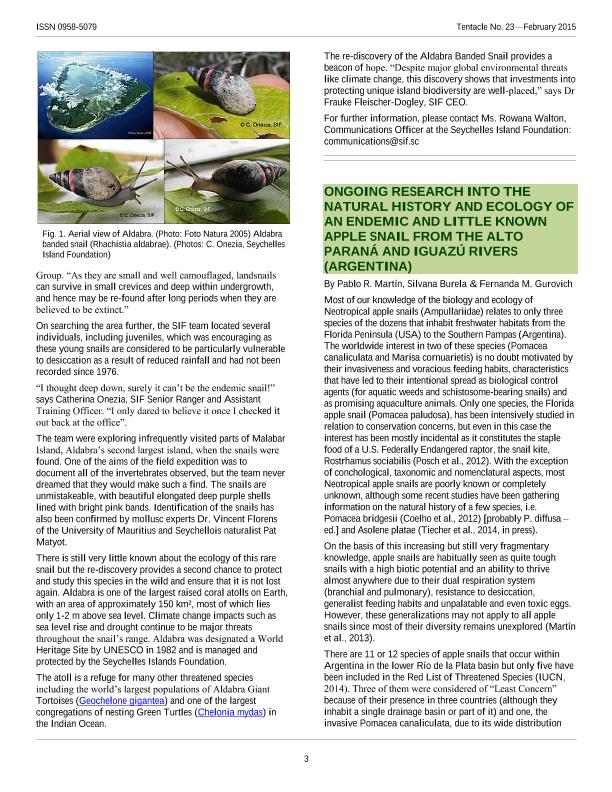Artículo
Ongoing research into the natural history and ecology of an endemic and little known apple snail from the Alto Paraná and Iguazú rivers (Argentina)
Fecha de publicación:
02/2015
Editorial:
International Union for Conservation of Nature
Revista:
Tentacle
ISSN:
0958-5079
Idioma:
Inglés
Tipo de recurso:
Artículo publicado
Clasificación temática:
Resumen
Most of the knowledge about the biology and ecology of Neotropical apple snails (family Ampullariidae) belongs to just three species out of the dozens that inhabit freshwater habitats distributed from the Florida Peninsula (USA) to Southern Pampas (Argentina). The worldwide interest in two of these species (Pomacea canaliculata and Marisa cornuarietis) no doubt came from their invasiveness and voracious feeding habits which promoted their intentional spread as biological control agents (for aquatic weeds and schistosome-bearing snails) or as promising aquaculture animals. Only one species, the Florida apple snail (Pomacea paludosa) has been intensively studied due to conservation concerns, although even in this case the interest has been mostly vicarious as it constitutes the staple food of a U.S. Federally Endangered raptor, the Snail Kite Rostrhamus sociabilis (Posch et al., 2012). Exception made of conchological, nomenclatural and taxonomical aspects, most Neotropical apple snails are poorly know or just unknown, although some recent studies have been gathering information on the natural history of a few species, as Pomacea bridgesii and Asolene platae.
Palabras clave:
Pomacea Americanista
,
Native Range
,
Vulnerable Species
,
Rearing
Archivos asociados
Licencia
Identificadores
Colecciones
Articulos(INBIOSUR)
Articulos de INSTITUTO DE CIENCIAS BIOLOGICAS Y BIOMEDICAS DEL SUR
Articulos de INSTITUTO DE CIENCIAS BIOLOGICAS Y BIOMEDICAS DEL SUR
Citación
Martín, Pablo Rafael; Burela, Silvana; Gurovich, Fernanda Mariel; Ongoing research into the natural history and ecology of an endemic and little known apple snail from the Alto Paraná and Iguazú rivers (Argentina); International Union for Conservation of Nature; Tentacle; 23; 2-2015; 3-6
Compartir




